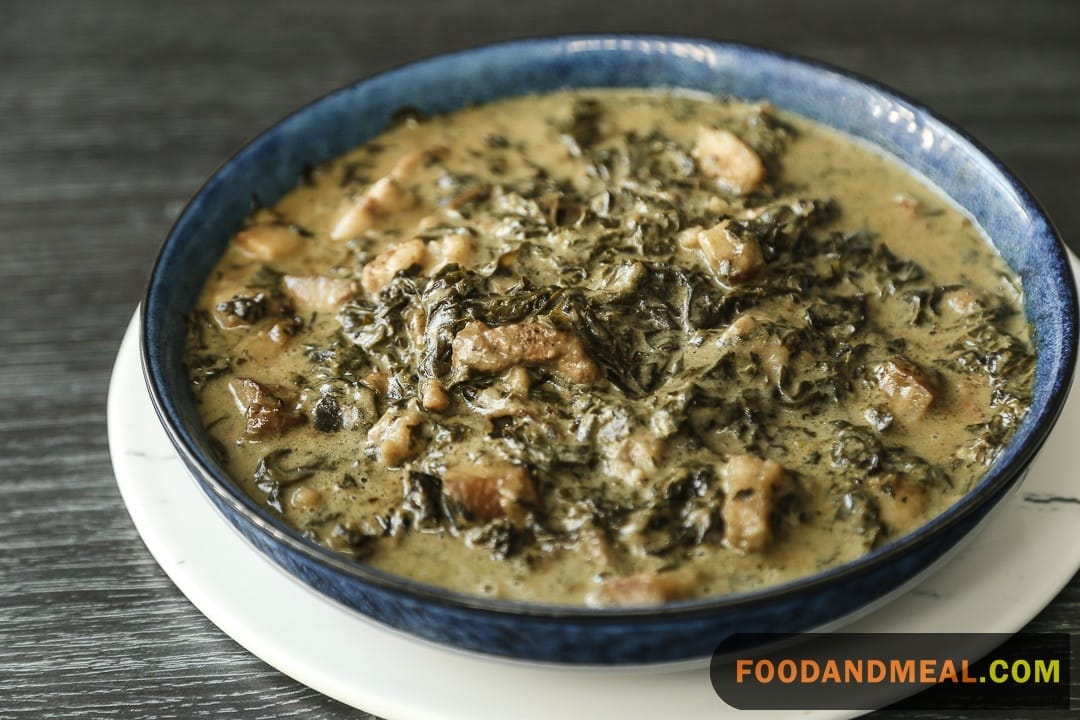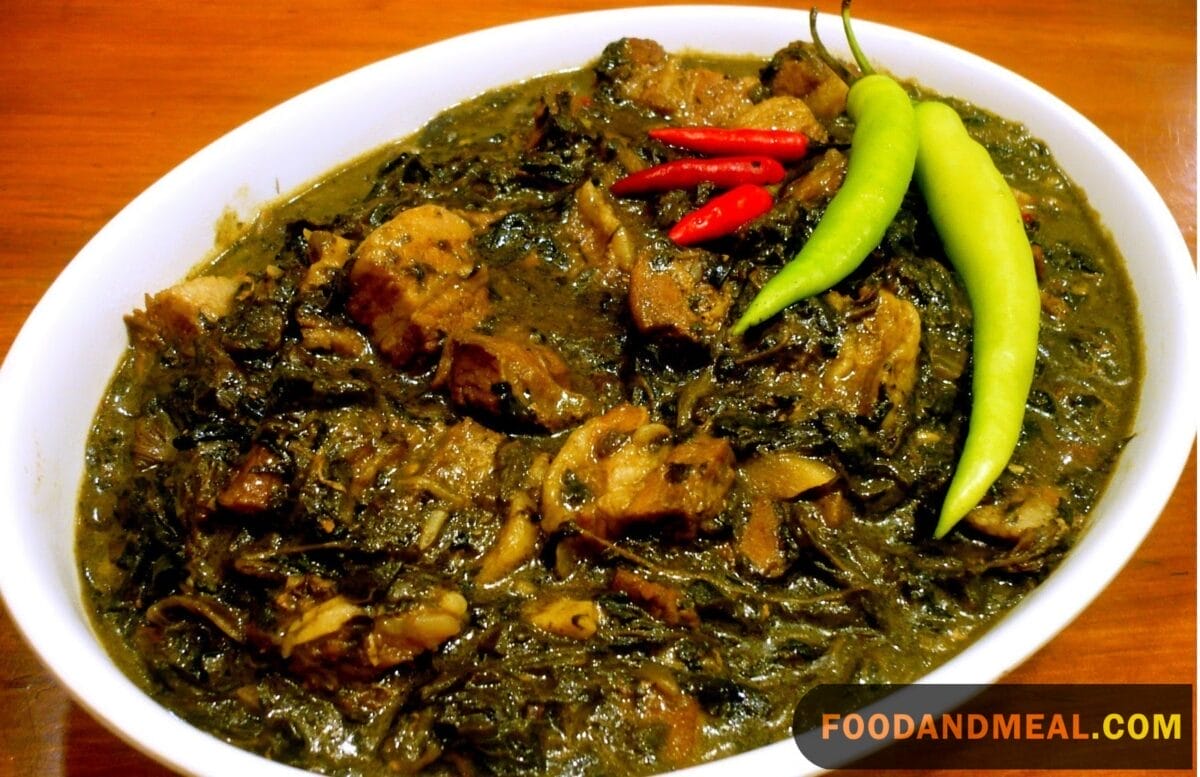Hello, food lovers! It’s JaimeInez here from Food and Meal, and today I’m excited to share with you a culinary journey to the beautiful province of Romblon in the Philippines. We’re going to explore a unique dish that has captured my heart (and taste buds) – the Romblon Gayabon.
Romblon Gayabon is a vegetable dish that originated in the province of Romblon. It’s prepared with fresh taro leaves and coconut milk, creating a creamy, soft, and pasty texture that’s simply irresistible. If you’ve ever tried Laing, a popular Filipino dish, you might find some similarities. However, there are key differences that make Romblon Gayabon stand out.
Unlike Laing, which uses sun-dried taro leaves, Romblon Gayabon uses fresh leaves. This gives the dish a chunkier texture and a more vibrant flavor. Plus, it’s not spicy, making it a great option for those who prefer milder dishes.
Romblon Gayabon Recipe


Romblon’s Gayabon
Ingredients
- 4 cups fresh gabi leaves torn into 1-inch pieces
- 1 lb. pork belly diced
- 1 pc onion thinly sliced
- 3 garlic cloves minced
- 1 tbsp ginger crushed and chopped
- 1 cup coconut cream
- 4 cups coconut milk
- 3 pcs chili peppers chopped
- 1 tbsp shrimp paste
- 1 tbsp oil
- Pinch of salt
Instructions
- Heat oil in a pan over medium fire and sauté garlic, ginger, and onions, stirring for about 5 minutes until fragrant.
- Stir in pork until browned a little, then, add shrimp paste and cook for 3 minutes.
- Whisk in coconut milk and simmer.
- Stir in gabi leaves, mashing with a spoon until it absorbs the moisture of coconut milk.
- Add chilies and boil. Reduce heat to low and cook for about half an hour until soft.
- Blend in coconut cream, season with salt, and cook for another 15 minutes until much of the moisture is absorbed.
- Serve with steamed white rice.
Video
Notes
cuisine is somehow influenced by the coconut-cream-and-chili-oriented
Bicolano fare. Gayabon is their answer to the former’s Laing dish. It’s mostly
the same recipe except for the fact that theirs uses fresh taro leaves instead of
dried, making the texture chunkier and that they like it less spicy than the
original version.
Nutrition
© Food And Meal
This website provides approximate nutrition information for convenience and as a courtesy only. Nutrition data is gathered primarily from the Spoonacular Database, whenever available, or otherwise other online calculators.
How to cook Romblon Gayabon using a slow cooker

- Preparation of Ingredients: Start by preparing your ingredients. This would typically involve chopping vegetables, slicing meat into chunks, and mincing or grating aromatics like garlic and ginger.
- Searing: Many Filipino stews start by searing the meat. While this step isn’t necessary with a slow cooker, it can add depth of flavor. To sear the meat, heat oil in a pan over high heat, add the meat in a single layer, and cook until browned on all sides. Once the meat is browned, remove it from the pan and place it in the slow cooker.
- Sautéing: Next, sauté your aromatics (like onions, garlic, and ginger) in the same pan used for searing. Once they’re fragrant, add them to the slow cooker as well.
- Deglazing: If your recipe calls for any liquids (like vinegar, soy sauce, or broth), you can add them to the hot pan to deglaze it. This will lift any flavorful bits stuck to the bottom of the pan. Add this liquid to the slow cooker.
- Slow Cooking: Now that all your ingredients are in the slow cooker, cover it and cook on low for 6-8 hours or on high for 3-4 hours. Different cuts of meat might require different cooking times, so adjust accordingly.
- Final Steps: If your recipe includes vegetables that should be added later in the cooking process, you can add them in the last hour of cooking.
- Seasoning: Finally, after the dish is cooked, adjust the seasoning as needed before serving.
Tips for making Romblon Gayabon

Cooking Tips
- Use Fresh Taro Leaves: The freshness of the taro leaves is crucial in achieving the authentic taste of Romblon Gayabon. Make sure to choose leaves that are vibrant in color and free from any spots or blemishes.
- Don’t Overmix: When adding the taro leaves to the coconut milk, try to submerge them gently without overmixing. This helps to maintain the chunky texture of the dish.
- Simmer Slowly: Allow the dish to simmer slowly to let the flavors meld together. This also helps the taro leaves to become tender and absorb the rich coconut milk.
Serving Suggestions
Romblon Gayabon can be served as a main course or a side dish. It pairs well with steamed rice and grilled or fried fish. For a complete Filipino meal, you can also serve it with other popular dishes from Romblon like kinilaw (a type of ceviche), adobo, sinigang, and lechon kawali.
FAQs
- What if I can’t find fresh taro leaves? If fresh taro leaves are not available, you can use spinach as a substitute. However, keep in mind that spinach cooks faster than taro leaves.
- Can I make Romblon Gayabon spicy? Absolutely! Feel free to add some chili peppers if you prefer a spicy kick.
- Can I use canned coconut milk? Yes, canned coconut milk can be used if fresh coconut milk is not available. Just make sure to choose a high-quality brand for the best flavor.
- How long can I store Romblon Gayabon? You can store it in the refrigerator for up to 3 days. Just make sure to reheat it properly before serving.
- Can I freeze Romblon Gayabon? Yes, you can freeze it for up to a month. Thaw it in the refrigerator overnight before reheating.
Now, let’s get creative in the kitchen. Have you ever thought about using a handheld milk frother to blend the coconut milk for a smoother texture? Or how about chopping the taro leaves over a Bundt pan for easier cleanup? The possibilities are endless!
- Cooking Like A Pro
- Author Name : Jaime Inez
- Address: Times Street, West Triangle, 1103, Quezon City, Metro Manila, Philippines
- Phone: 96-2-4108596
- Email: Contact@cookinglikeapro.net



